Social-Ecological Archetypes of Land Degradation in the Nigerian Guinea Savannah: Insights for Sustainable Land Management
Abstract
1. Introduction
2. Materials and Methods
2.1. Study Area
2.2. Framing Land-Degradation Drivers
2.3. Datasets Selection
2.3.1. Land-Use Management Practices
2.3.2. Socio-Economic Drivers
2.3.3. Environmental Drivers
2.4. Methods
2.4.1. Conceptual Framework
2.4.2. Identifying Archetypes of Land-Degradation Drivers Using Self-Organizing Maps
2.4.3. Linking Archetypes of Land-Degradation Drivers to State Administrations and Land Status
3. Results
3.1. Land-Degradation Status
3.2. Land-Degradation Archetypes
3.3. Spatial Distribution of Archetypes
3.4. Categories of Archetypes According to State Administrative Boundaries and LD Status
3.4.1. Degree of Land-Degradation Status per Archetype
3.4.2. Share of Land-Degradation Archetypes per State Administration Unit
4. Discussion
4.1. Understanding the Archetypes of Large-Area Degradation
4.2. Understanding the Archetypes of Small-Area Degradation
4.3. Archetypes and Policy Insights
4.4. Archetypes and Sustainable Land Management (SLM)
5. Conclusions
Supplementary Materials
Author Contributions
Funding
Acknowledgments
Conflicts of Interest
References
- Sims, N.C.; Barger, N.N.; Metternicht, G.I.; England, J.R. A land degradation interpretation matrix for reporting on UN SDG indicator 15.3.1 and land degradation neutrality. Environ. Sci. Policy 2020, 114, 1–6. [Google Scholar] [CrossRef]
- Laestadius, L.; Maginnis, S.; Minnemeyer, S.; Potapov, P.; Saint-Laurent, C.; Sizer, N. Mapping opportunities for forest landscape restoration. Unasylva 2011, 62, 47–48. [Google Scholar]
- Goffner, D.; Sinare, H.; Gordon, L.J. The Great Green Wall for the Sahara and the Sahel Initiative as an opportunity to enhance resilience in Sahelian landscapes and livelihoods. Reg. Environ. Chang. 2019, 19, 1417–1428. [Google Scholar] [CrossRef]
- Olsson, L.; Barbosa, H.; Bhadwal, S.; Cowie, A.; Delusca, K.; Flores-Renteria, D.; Hermans, K.; Jobbagy, E.; Kurz, W.; Li, D.; et al. Land Degradation. In Climate Change and Land: An IPCC Special Report on Climate Change, Desertification, Land Degradation, Sustainable Land Management, Food Security, and Greenhouse Gas Fluxes in Terrestrial Ecosystems; IPCC Press Office: Geneva, Switzerland, 2019; pp. 345–436. [Google Scholar]
- Akinyemi, F.O.; Tlhalerwa, L.T.; Eze, P.N. Land degradation assessment in an African dryland context based on the Composite Land Degradation Index and mapping method. Geocarto Int. 2019, 1–17. [Google Scholar] [CrossRef]
- Southworth, J.; Zhu, L.; Bunting, E.; Ryan, S.J.; Herrero, H.; Waylen, P.R.; Hill, M.J. Changes in vegetation persistence across global savanna landscapes, 1982–2010. J. Land Use Sci. 2016, 11, 7–32. [Google Scholar] [CrossRef]
- Ellison, D.; Ifejika Speranza, C. From blue to green water and back again: Promoting tree, shrub and forest-based landscape resilience in the Sahel. Sci. Total Environ. 2020, 739, 140002. [Google Scholar] [CrossRef]
- UNCCD. The Global Land Outlook, West Africa Thematic Report; United Nations Convention to Combat Desertification: Bonn, Germany, 2019. [Google Scholar]
- Höhn, A.; Neumann, K. Shifting cultivation and the development of a cultural landscape during the Iron Age (0–1500 AD) in the northern Sahel of Burkina Faso, West Africa: Insights from archaeological charcoal. Quat. Int. 2012, 249, 72–83. [Google Scholar] [CrossRef]
- Ifejika Speranza, C.; Adenle, A.; Boillat, S. Land Degradation Neutrality—Potentials for its operationalisation at multi-levels in Nigeria. Environ. Sci. Policy 2019, 94, 63–71. [Google Scholar] [CrossRef]
- Adenle, A.A.; Eckert, S.; Speranza, C.I.; Adedeji, O.I.; Ellison, D. Human-induced land degradation dominance in the Nigerian Guinea savannah between 2003–2018. Remote Sens. Appl. Soc. Environ. 2020, 100360. [Google Scholar] [CrossRef]
- CILSS (Comité Permanent Inter-états de Lutte contre la Sécheresse dans le Sahel). Landscapes of West Africa—A Window on a Changing World; CILSS: Garretson, SD, USA, 2016. [Google Scholar]
- Arowolo, A.O.; Deng, X. Land use/land cover change and statistical modelling of cultivated land change drivers in Nigeria. Reg. Environ. Chang. 2018, 18, 247–259. [Google Scholar] [CrossRef]
- Lambin, E.F.; Geist, H.J.; Lepers, E. Dynamics of Land-Use and Land-Cover Change in Tropical Regions. Annu. Rev. Environ. Resour. 2003, 28, 205–241. [Google Scholar] [CrossRef]
- Macaulay, B.M. Land degradation in Northern Nigeria: The impacts and implications of human-related and climatic factors. Afr. J. Environ. Sci. Technol. 2014, 8, 267–273. [Google Scholar] [CrossRef]
- Mirzabaev, A.; Nkonya, E.; Goedecke, J.; Johnson, T.; Anderson, W. Global Drivers of Land Degradation and Improvement. In Economics of Land Degradation and Improvement—A Global Assessment for Sustainable Development; Nkonya, E., Mirzabaev, A., von Braun, J., Eds.; Springer: Cham, Switzerland, 2016; pp. 167–195. ISBN 978-3-319-19168-3. [Google Scholar]
- Batunacun; Wieland, R.; Lakes, T.; Yunfeng, H.; Nendel, C. Identifying drivers of land degradation in Xilingol, China, between 1975 and 2015. Land Use Policy 2019, 83, 543–559. [Google Scholar] [CrossRef]
- Sietz, D.; Fleskens, L.; Stringer, L.C. Learning from Non-Linear Ecosystem Dynamics Is Vital for Achieving Land Degradation Neutrality. Land Degrad. Dev. 2017, 28, 2308–2314. [Google Scholar] [CrossRef]
- Oberlack, C.; Sietz, D.; Bürgi Bonanomi, E.; de Bremond, A.; Dell’Angelo, J.; Eisenack, K.; Ellis, E.; Epstein, G.; Giger, M.; Heinimann, A.; et al. Archetype analysis in sustainability research: Meanings, motivations, and evidence-based policy making. Ecol. Soc. 2019, 24. [Google Scholar] [CrossRef]
- Levers, C.; Müller, D.; Erb, K.; Haberl, H.; Jepsen, M.R.; Metzger, M.J.; Meyfroidt, P.; Plieninger, T.; Plutzar, C.; Stürck, J.; et al. Archetypical patterns and trajectories of land systems in Europe. Reg. Environ. Chang. 2018, 18, 715–732. [Google Scholar] [CrossRef]
- Sietz, D.; Mamani Choque, S.E.; Lüdeke, M.K.B. Typical patterns of smallholder vulnerability to weather extremes with regard to food security in the Peruvian Altiplano. Reg. Environ. Chang. 2012, 12, 489–505. [Google Scholar] [CrossRef]
- Merino, M.V.; Sietz, D.; Jost, F.; Berger, U. Archetypes of Climate Vulnerability: A Mixed-method Approach Applied in the Peruvian Andes. Clim. Dev. 2019, 11, 418–434. [Google Scholar] [CrossRef]
- Dittrich, A.; Seppelt, R.; Václavík, T.; Cord, A.F. Integrating ecosystem service bundles and socio-environmental conditions—A national scale analysis from Germany. Ecosyst. Serv. 2017, 28, 273–282. [Google Scholar] [CrossRef]
- Oberlack, C.; Eisenack, K. Archetypical barriers to adapting water governance in river basins to climate change. J. Inst. Econ. 2018, 14, 527–555. [Google Scholar] [CrossRef]
- Václavík, T.; Lautenbach, S.; Kuemmerle, T.; Seppelt, R. Mapping global land system archetypes. Glob. Environ. Chang. 2013, 23, 1637–1647. [Google Scholar] [CrossRef]
- Iloeje, N.P. A New Geography of Nigeria; New Revised Edition; Longman Nig. Ltd.: Lagos, Nigeria, 2001; p. 200. [Google Scholar]
- Nigeria’s First National Communication under the United Nations Framework Convention on Climate Change; The Ministry of the Environment of the Federal 11 Republic of Nigeria: Abuja, Nigeria, 2003.
- Mulinge, W.; Gicheru, P.; Murithi, F.; Maingi, P.; Kihiu, E.; Kirui, O.K.; Mirzabaev, A. Economics of Land Degradation and Improvement in Kenya. In Economics of Land Degradation and Improvement—A Global Assessment for Sustainable Development; Nkonya, E., Mirzabaev, A., von Braun, J., Eds.; Springer: Cham, Switzerland, 2016; pp. 471–498. ISBN 978-3-319-19167-6. [Google Scholar]
- Vu, Q.M.; Le, Q.B.; Frossard, E.; Vlek, P.L.G. Socio-economic and biophysical determinants of land degradation in Vietnam: An integrated causal analysis at the national level. Land Use Policy 2014, 36, 605–617. [Google Scholar] [CrossRef]
- FGN (Federal Government of Nigeria). Final Report of the Land Degradation Neutrality Target Setting Programme; FGN: Abuja, Nigeria, 2018.
- Malek, Ž.; Douw, B.; Van Vliet, J.; Van Der Zanden, E.H.; Verburg, P.H. Local land-use decision-making in a global context. Environ. Res. Lett. 2019, 14, 083006. [Google Scholar] [CrossRef]
- Zhu, Z.; Piao, S.; Myneni, R.B.; Huang, M.; Zeng, Z.; Canadell, J.G.; Ciais, P.; Sitch, S.; Friedlingstein, P.; Arneth, A.; et al. Greening of the Earth and its drivers. Nat. Clim. Chang. 2016, 6, 791–795. [Google Scholar] [CrossRef]
- Olorunfemi, I.E.; Fasinmirin, J.T.; Olufayo, A.A.; Komolafe, A.A. GIS and remote sensing-based analysis of the impacts of land use/land cover change (LULCC) on the environmental sustainability of Ekiti State, southwestern Nigeria. Environ. Dev. Sustain. 2020, 22, 661–692. [Google Scholar] [CrossRef]
- WorldPop. Global 100m Covariates; WorldPop: School of Geography and Environmental Science, University of Southampton; Department of Geography and Geosciences, University of Louisville; Departement de Geographie, Universite de Namur) and Center for International Earth Science Information Network (CIESIN), Columbia University 2018. Global High Resolution Population Denominators Project—Funded by the Bill and Melinda Gates Foundation (OPP1134076). Available online: https://dx.doi.org/10.5258/SOTON/WP00645 (accessed on 17 November 2020).
- Tiffen, M.; Mortimore, M.; Gichuki, F. More People, Less Erosion: Environmental Recovery in KENYA; John and Wiley: Chichester, NY, USA, 1994; ISBN 978-0-471-94143-9. [Google Scholar]
- Abdulaziz, H.; Johar, F.; Majid, M.R.; Medugu, N.I. Protected area management in Nigeria: A review. J. Teknol. 2015, 77. [Google Scholar] [CrossRef]
- Bosco, C.; Alegana, V.; Bird, T.; Pezzulo, C.; Bengtsson, L.; Sorichetta, A.; Steele, J.; Hornby, G.; Ruktanonchai, C.; Ruktanonchai, N.; et al. Exploring the high-resolution mapping of gender-disaggregated development indicators. J. R. Soc. Interface 2017, 14, 20160825. [Google Scholar] [CrossRef] [PubMed]
- Gnacadja, L.; Wiese, L. Land Degradation Neutrality: Will Africa Achieve It? Institutional Solutions to Land Degradation and Restoration in Africa. In Climate Change and Multi-Dimensional Sustainability in African Agriculture; Lal, R., Kraybill, D., Hansen, D.O., Singh, B.R., Mosogoya, T., Eik, L.O., Eds.; Springer: Cham, Switzerland, 2016; pp. 61–95. ISBN 978-3-319-41236-8. [Google Scholar]
- Jendoubi, D.; Liniger, H.; Ifejika Speranza, C. Impacts of land use and topography on soil organic carbon in a Mediterranean landscape (north-western Tunisia). Soil 2019, 5, 239–251. [Google Scholar] [CrossRef]
- Lloyd, C.T.; Chamberlain, H.; Kerr, D.; Yetman, G.; Pistolesi, L.; Stevens, F.R.; Gaughan, A.E.; Nieves, J.J.; Hornby, G.; MacManus, K.; et al. Global spatio-temporally harmonised datasets for producing high-resolution gridded population distribution datasets. Big Earth Data 2019, 3, 108–139. [Google Scholar] [CrossRef]
- Salako, F.K.; Hauser, S.; Babalola, O.; Tian, G. Improvement of the physical fertility of a degraded Alfisol with planted and natural fallows under humid tropical conditions. Soil Use Manag. 2006, 17, 41–47. [Google Scholar] [CrossRef]
- Enang, R.K.; Yerima, B.P.K.; Kome, G.K.; Van Ranst, E. Effects of Forest Clearance and Cultivation on Bulk Density Variations and Relationships with Texture and Organic Matter in Tephra Soils of Mount Kupe (Cameroon). Commun. Soil Sci. Plant Anal. 2017, 48, 2231–2245. [Google Scholar] [CrossRef]
- Imbrenda, V.; D’emilio, M.; Lanfredi, M.; Macchiato, M.; Ragosta, M.; Simoniello, T. Indicators for the estimation of vulnerability to land degradation derived from soil compaction and vegetation cover: Indicators for the estimation of soil degradation. Eur. J. Soil Sci. 2014, 65, 907–923. [Google Scholar] [CrossRef]
- Nadporozhskaya, M.A.; Chertov, O.G.; Bykhovets, S.S.; Shaw, C.H.; Maksimova, E.Y.; Abakumov, E.V. Recurring surface fires cause soil degradation of forest land: A simulation experiment with the EFIMOD model. Land Degrad. Dev. 2018, 29, 2222–2232. [Google Scholar] [CrossRef]
- Miquelajauregui, Y.; Cumming, S.G.; Gauthier, S. Modelling Variable Fire Severity in Boreal Forests: Effects of Fire Intensity and Stand Structure. PLoS ONE 2016, 11, e0150073. [Google Scholar] [CrossRef] [PubMed]
- Veldman, J.W. Clarifying the confusion: Old-growth savannahs and tropical ecosystem degradation. Phil. Trans. R. Soc. B 2016, 371, 20150306. [Google Scholar] [CrossRef] [PubMed]
- Kosmas, C.; Detsis, V.; Karamesouti, M.; Kounalaki, K.; Vassiliou, P.; Salvati, L. Exploring Long-Term Impact of Grazing Management on Land Degradation in the Socio-Ecological System of Asteroussia Mountains, Greece. Land 2015, 4, 541–559. [Google Scholar] [CrossRef]
- Bado, V.B.; Bationo, A. Integrated Management of Soil Fertility and Land Resources in Sub-Saharan Africa: Involving Local Communities. In Advances in Agronomy; Elsevier: Amsterdam, The Netherlands, 2018; Volume 150, pp. 1–33. ISBN 978-0-12-815175-4. [Google Scholar]
- Deng, X.; Huang, J.; Huang, Q.; Rozelle, S.; Gibson, J. Do roads lead to grassland degradation or restoration? A case study in Inner Mongolia, China. Environ. Dev. Econ. 2011, 16, 751–773. [Google Scholar] [CrossRef]
- Li, W.; Buitenwerf, R.; Munk, M.; Amoke, I.; Bøcher, P.K.; Svenning, J.-C. Accelerating savanna degradation threatens the Maasai Mara socio-ecological system. Glob. Environ. Chang. 2020, 60, 102030. [Google Scholar] [CrossRef]
- De la Fuente, B.; Weynants, M.; Bertzky, B.; Delli, G.; Mandrici, A.; Bendito, E.G.; Dubois, G. Land Productivity Dynamics in and around Protected Areas Globally from 1999 to 2013. PLoS ONE 2020, 15, e0224958. [Google Scholar] [CrossRef]
- Nabiollahi, K.; Golmohamadi, F.; Taghizadeh-Mehrjardi, R.; Kerry, R.; Davari, M. Assessing the effects of slope gradient and land use change on soil quality degradation through digital mapping of soil quality indices and soil loss rate. Geoderma 2018, 318, 16–28. [Google Scholar] [CrossRef]
- Qasim, M.; Hubacek, K.; Termansen, M.; Fleskens, L. Modelling land use change across elevation gradients in district Swat, Pakistan. Reg. Environ. Chang. 2013, 13, 567–581. [Google Scholar] [CrossRef]
- Kohonen, T. Self-Organizing Maps; Springer Series in Information Sciences; Springer: Berlin/Heidelberg, Germany, 2001; Volume 30, ISBN 978-3-540-67921-9. [Google Scholar]
- Moosavi, V. Contextual mapping: Visualization of high-dimensional spatial patterns in a single geo-map. Comput. Environ. Urban Syst. 2017, 61, 1–12. [Google Scholar] [CrossRef]
- Oldeman, L.R.; Hakkeling, R.T.A.; Sombroek, W.G.; International Soil Reference and Information Centre; United Nations. Environment Programme World Map of the Status of Human-Induced Soil Degradation an Explanatory Note; International Soil Reference and Information Centre: Wageningen, The Netherlands; Nairobi, Kenya, 1991. [Google Scholar]
- Andela, N.; van der Werf, G.R. Recent trends in African fires driven by cropland expansion and El Niño to La Niña transition. Nat. Clim. Chang. 2014, 4, 791–795. [Google Scholar] [CrossRef]
- Woollen, E.; Ryan, C.M.; Baumert, S.; Vollmer, F.; Grundy, I.; Fisher, J.; Fernando, J.; Luz, A.; Ribeiro, N.; Lisboa, S.N. Charcoal production in the Mopane woodlands of Mozambique: What are the trade-offs with other ecosystem services? Phil. Trans. R. Soc. B 2016, 371, 20150315. [Google Scholar] [CrossRef] [PubMed]
- Barbier, E.B.; Hochard, J.P. Does Land Degradation Increase Poverty in Developing Countries? PLoS ONE 2016, 11, e0152973. [Google Scholar] [CrossRef] [PubMed]
- Nkonya, E.; Mirzabaev, A.; von Braun, J. Economics of Land Degradation and Improvement: An Introduction and Overview. In Economics of Land Degradation and Improvement—A Global Assessment for Sustainable Development; Nkonya, E., Mirzabaev, A., von Braun, J., Eds.; Springer International Publishing: Cham, Switzerland, 2016; pp. 1–14. ISBN 978-3-319-19168-3. [Google Scholar]
- Gadzama, N.M.; Ayuba, H.K. On major environmental problem of desertification in Northern Nigeria with sustainable efforts to managing it. World J. Sci. Technol. Sustain. Dev. 2016, 13, 18–30. [Google Scholar] [CrossRef]
- Gadzama, N.M. Attenuation of the effects of desertification through sustainable development of Great Green Wall in the Sahel of Africa. World J. Sci. Technol. Sustain. Dev. 2017, 14, 279–289. [Google Scholar] [CrossRef]
- Ayanlade, A.; Drake, N. Forest loss in different ecological zones of the Niger Delta, Nigeria: Evidence from remote sensing. GeoJournal 2016, 81, 717–735. [Google Scholar] [CrossRef]
- Kiage, L.M. Perspectives on the assumed causes of land degradation in the rangelands of Sub-Saharan Africa. Prog. Phys. Geogr. Earth Environ. 2013, 37, 664–684. [Google Scholar] [CrossRef]
- Pingali, P.; Schneider, K.; Zurek, M. Poverty, Agriculture and the Environment: The Case of Sub-Saharan Africa. In Marginality: Addressing the Nexus of Poverty, Exclusion and Ecology; von Braun, J., Gatzweiler, F.W., Eds.; Springer: Dordrecht, The Netherlands, 2014; pp. 151–168. ISBN 978-94-007-7061-4. [Google Scholar]
- Eisenack, K.; Villamayor-Tomas, S.; Epstein, G.; Kimmich, C.; Magliocca, N.; Manuel-Navarrete, D.; Oberlack, C.; Roggero, M.; Sietz, D. Design and quality criteria for archetype analysis. Ecol. Soc. 2019, 24. [Google Scholar] [CrossRef]
- Ducrotoy, M.J.; Majekodunmi, A.O.; Shaw, A.P.M.; Bagulo, H.; Bertu, W.J.; Gusi, A.M.; Ocholi, R.; Welburn, S.C. Patterns of passage into protected areas: Drivers and outcomes of Fulani immigration, settlement and integration into the Kachia Grazing Reserve, northwest Nigeria. Pastoralism 2018, 8, 1. [Google Scholar] [CrossRef] [PubMed]
- Nchor, A.A.; Ogogo, A.U. Rapid assessment of protected area pressures and threats in Nigeria national parks. Glob. J. Agric. Sci. 2012, 11, 63–72. [Google Scholar] [CrossRef]
- Mirzabaev, A. Land Degradation and Sustainable Land Management Innovations in Central Asia. In Technological and Institutional Innovations for Marginalized Smallholders in Agricultural Development; Gatzweiler, F.W., von Braun, J., Eds.; Springer: Cham, Switzerland, 2016; pp. 213–224. ISBN 978-3-319-25718-1. [Google Scholar]
- Abbas, I.I.; Fasona, M.J. The Human Perception of Land Degradation in a Section of Niger Delta, Nigeria. Mar. Sci. 2012, 2, 94–100. [Google Scholar] [CrossRef]
- Fasona, M.; Fabusoro, E.; Sodiya, C.; Adedayo, V.; Olorunfemi, F.; Elias, P.O.; Oyedepo, J.; Oloukoi, G. Some Dimensions of Farmers’-Pastoralists’ Conflicts in the Nigerian Savanna. J. Glob. Initiat. Policy Pedagog. Perspect. 2016, 10, 7. [Google Scholar]
- Naibbi, A.I.; Baily, B.; Healey, R.G.; Collier, P. Changing Vegetation Patterns in Yobe State Nigeria: An Analysis of the Rates of Change, Potential Causes and the Implications for Sustainable Resource Management. IJG 2014, 5, 50–62. [Google Scholar] [CrossRef]
- Akhtar-Schuster, M.; Thomas, R.J.; Stringer, L.C.; Chasek, P.; Seely, M. Improving the enabling environment to combat land degradation: Institutional, financial, legal and science-policy challenges and solutions. Land Degrad. Dev. 2011, 22, 299–312. [Google Scholar] [CrossRef]
- FGN Federal Government of Nigeria. Great Green Wall for the Sahara and Sahel Initiative National Strategic Action Plan; National Strategic Action Plan; Federal Ministry of Environment of Nigeria: Abuja, Nigeria, 2012.
- Onele, J. The Grazing Bill and the Right to Property in Nigeria: Lest We Are Deceived! SSRN J. 2016. [Google Scholar] [CrossRef]
- World Bank. Nigeria Agriculture and Rural Poverty: A Policy Note; World Bank: Washington, DC, USA, 2014. [Google Scholar]
- World Bank. Poverty Reduction in Nigeria in the Last Decade; World Bank: Washington, DC, USA, 2016. [Google Scholar]
- Umo, J.O. Escaping Poverty in Africa: A Perspective on Strastegic Agender for Nigeria, 2nd ed.; Millennium Text Publishers Ltd.: Lagos, Nigeria, 2012. [Google Scholar]
- Okoro, U.S.; Akpaeti, A.J.; Ekpo, U.N. Seasonality in income and poverty among rural food crop farmers in Akwaibom State, Nigeria. Russ. Agric. Sci. 2015, 41, 383–389. [Google Scholar] [CrossRef]
- UNESCO. Reaching the 2015 Literacy Target: Delivering on the Promise; High Level International Round Table on Literacy: Paris, France, 2012. [Google Scholar]
- Benjamin, A.M.N. Farmers’ Perception of Effectiveness of Agricultural Extension Delivery in Cross-River State, Nigeria. J. Agric. Vet. Sci. (IOSR-JAVS) 2013, 2, 1–7. [Google Scholar]
- Baloch, M.A.; Thapa, G.B. The effect of agricultural extension services: Date farmers’ case in Balochistan, Pakistan. J. Saudi Soc. Agric. Sci. 2018, 17, 282–289. [Google Scholar] [CrossRef]
- Lenhardt, A.; Glennie, J.; Intscher, N.; Ali, A.; Morin, G. A Greener BurkinA Sustainable Farming Techniques, Land Reclamation and Improved Livelihoods; Progress Case Study Report; Gallimard: Paris, France, 2014. [Google Scholar]
- Atuo, F.A.; Fu, J.; O’Connell, T.J.; Agida, J.A.; Agaldo, J.A. Coupling law enforcement and community-based regulations in support of compliance with biodiversity conservation regulations. Environ. Conserv. 2020, 47, 104–112. [Google Scholar] [CrossRef]
- Hughes, K.; Oduol, J.; Kegode, H.; Ouattara, I.; Vagen, T.; Winowiecki, L.A.; Bourne, M.; Neely, C.; Ademonla, A.D.; Carsan, S.; et al. Regreening Africa Consolidated Baseline Survey Report; World Agroforestry: Nairobi, Kenya, 2020. [Google Scholar]
- Ifejika Speranza, C.; Ochege, F.U.; Nzeadibe, T.C.; Agwu, A.E. Agricultural Resilience to Climate Change in Anambra State, Southeastern Nigeria. In Beyond Agricultural Impacts; Elsevier: Amsterdam, The Netherlands, 2018; pp. 241–274. ISBN 978-0-12-812624-0. [Google Scholar]
- Adewuyi, T.O.; Olofin, E.A. Sustainability of Fuel Wood Harvesting from Afaka Forest Reserve, Kaduna State, Nigeria. JAS 2014, 7, 129. [Google Scholar] [CrossRef]
- Ndiboi, S.; Makinde, D. Sustainable Fuelwood Management Project in Nigeria; Final Draft Midterm Review (MTR) REPORT: Abuja, Nigeria, 2020. [Google Scholar]
- Mononen, K.; Pitkänen, S. Sustainable Fuelwood Management in West Africa; University of Eastern Finland: Joensuu/Kuopio, Finland, 2016. [Google Scholar]
- Chazdon, R.L.; Uriarte, M. Natural regeneration in the context of large-scale forest and landscape restoration in the tropics. Biotropica 2016, 48, 709–715. [Google Scholar] [CrossRef]
- Idris Medugu, N.; Rafee Majid, M.; Johar, F.; Choji, I.D. The role of afforestation programme in combating desertification in Nigeria. Int. J. Clim. Chang. Strat. Manag. 2010, 2, 35–47. [Google Scholar] [CrossRef]
- Ibrahim, K.M.; Muhammad, S.I. A Review of Afforestation Efforts in Nigeria. Int. J. Adv. Res. Eng. Appl. Sci. 2015, 4, 24–37. [Google Scholar]
- Ibrahim, S.S.; Ozdeser, H.; Cavusoglu, B. Testing the impact of environmental hazards and violent conflicts on sustainable pastoral development: Micro-level evidence from Nigeria. Environ. Dev. Sustain. 2020, 22, 4169–4190. [Google Scholar] [CrossRef]
- FAO Food and Agriculture Organization. Improving Governance of Pastoral Lands. Governance of Tenure Technical Guides; FAO: Rome, Italy, 2017; Available online: www.fao.org/3/a-i5771e.pdf (accessed on 17 November 2020).
- Hannam, I. Governance of Pastoral Lands. In International Yearbook of Soil Law and Policy 2017; Ginzky, H., Dooley, E., Heuser, I.L., Kasimbazi, E., Markus, T., Qin, T., Eds.; Springer: Cham, Switzerland, 2018; Volume 2017, pp. 101–124. ISBN 978-3-319-68884-8. [Google Scholar]
- Sule, P.E. Open grazing prohibitions and the politics of exclusivist identity in Nigeria. Afr. Rev. 2020, 1–17. [Google Scholar] [CrossRef]
- Liniger, H.; Studer, R.M.; Hauert, C.; Gurtner, M.; Gämperli, U.; Kummer, S.; Hergarten, C. Sustainable Land Management in Practice—Guidelines and Best Practices for Sub-Saharan Africa; TerrAfrica; World Overview of Conservation Approaches and Technologies (WOCAT) and Food and Agriculture Organization of the United Nations (FAO): Midrand, South Africa, 2011; Volume 13. [Google Scholar]
- Liniger, H.; Harari, N.; van Lynden, G.; Fleiner, R.; de Leeuw, J.; Bai, Z.; Critchley, W. Achieving land degradation neutrality: The role of SLM knowledge in evidence-based decision-making. Environ. Sci. Policy 2019, 94, 123–134. [Google Scholar] [CrossRef]
- Ferro-Vázquez, C.; Lang, C.; Kaal, J.; Stump, D. When is a terrace not a terrace? The importance of understanding landscape evolution in studies of terraced agriculture. J. Environ. Manag. 2017, 202, 500–513. [Google Scholar] [CrossRef]
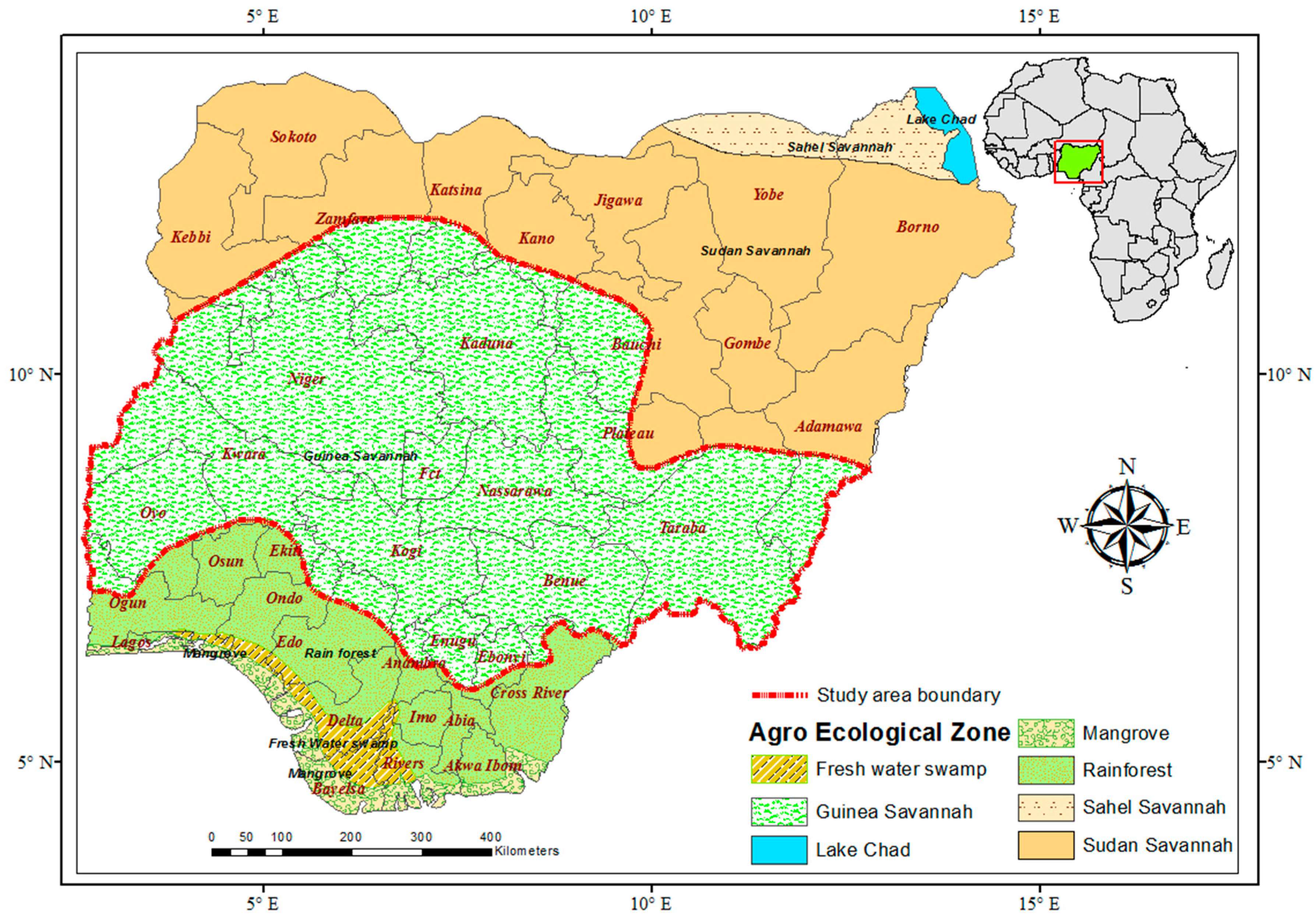
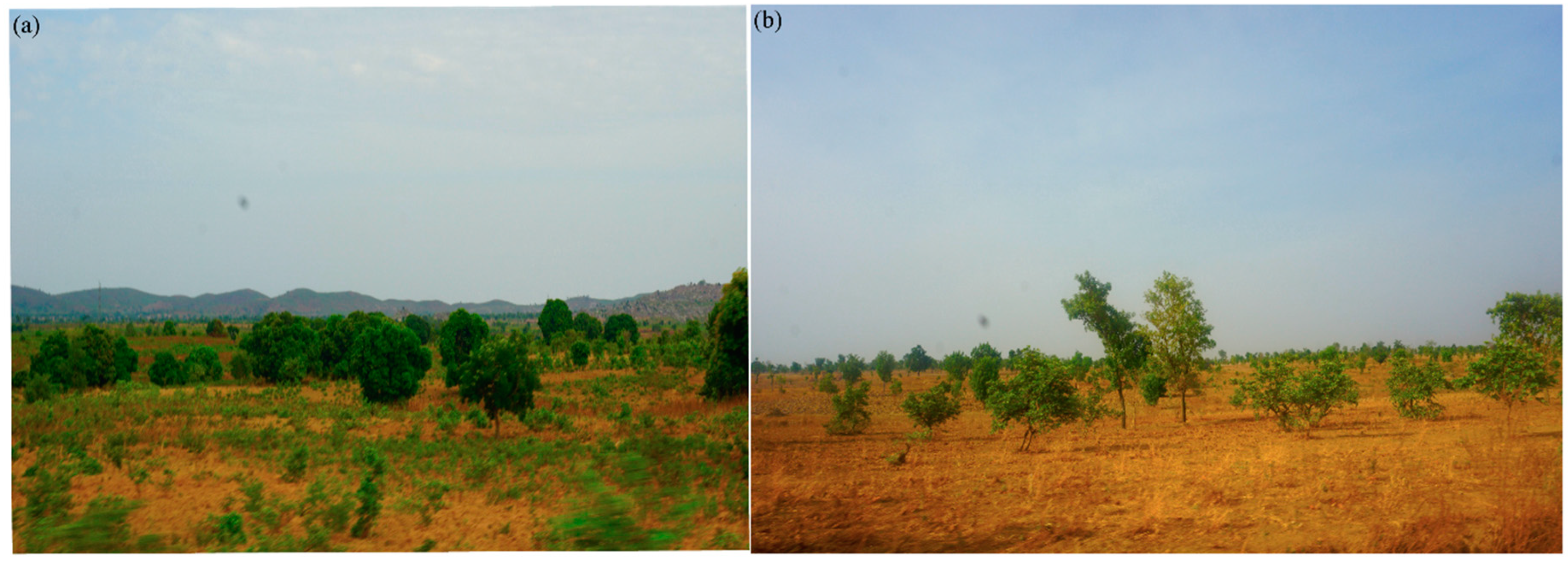

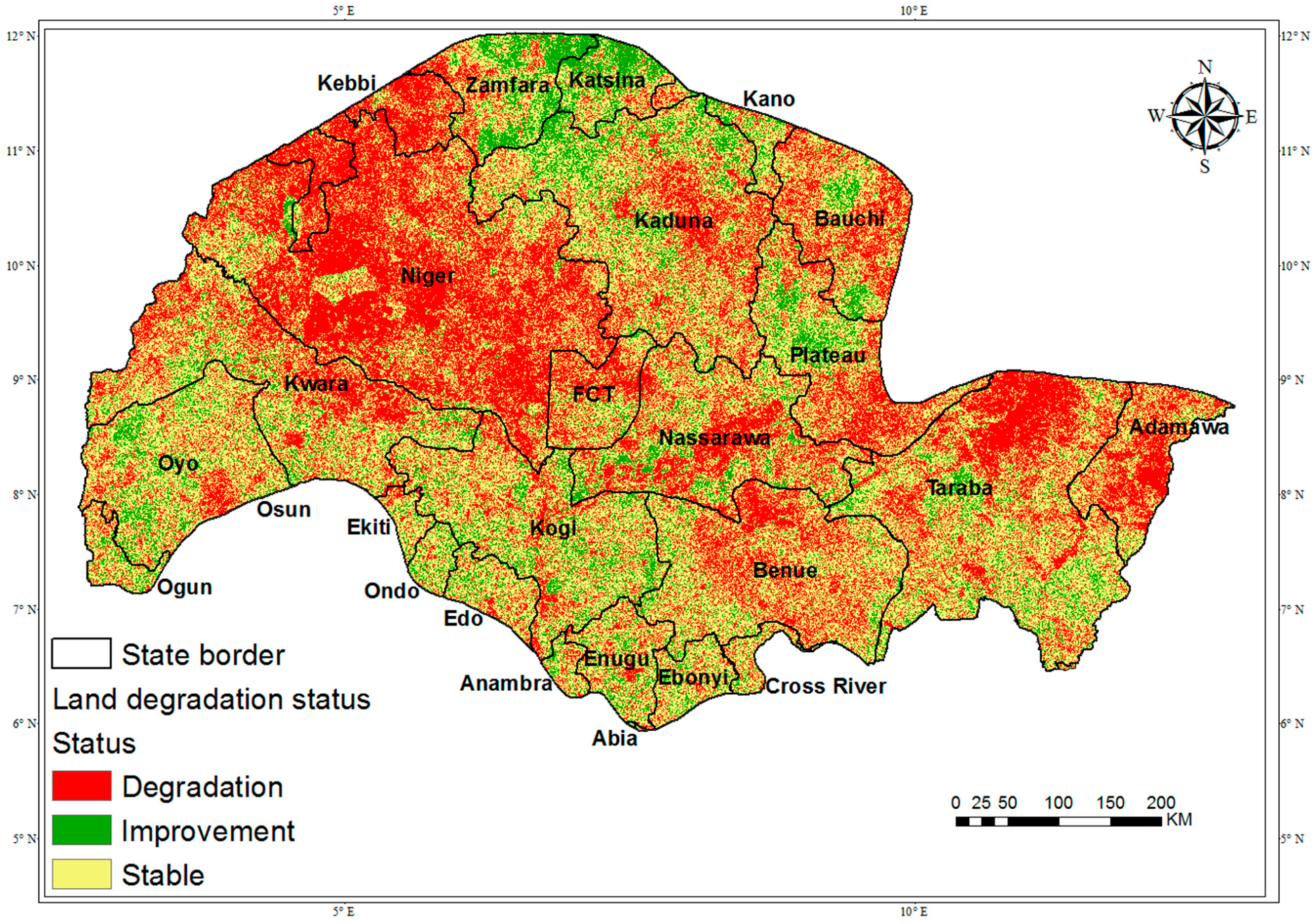
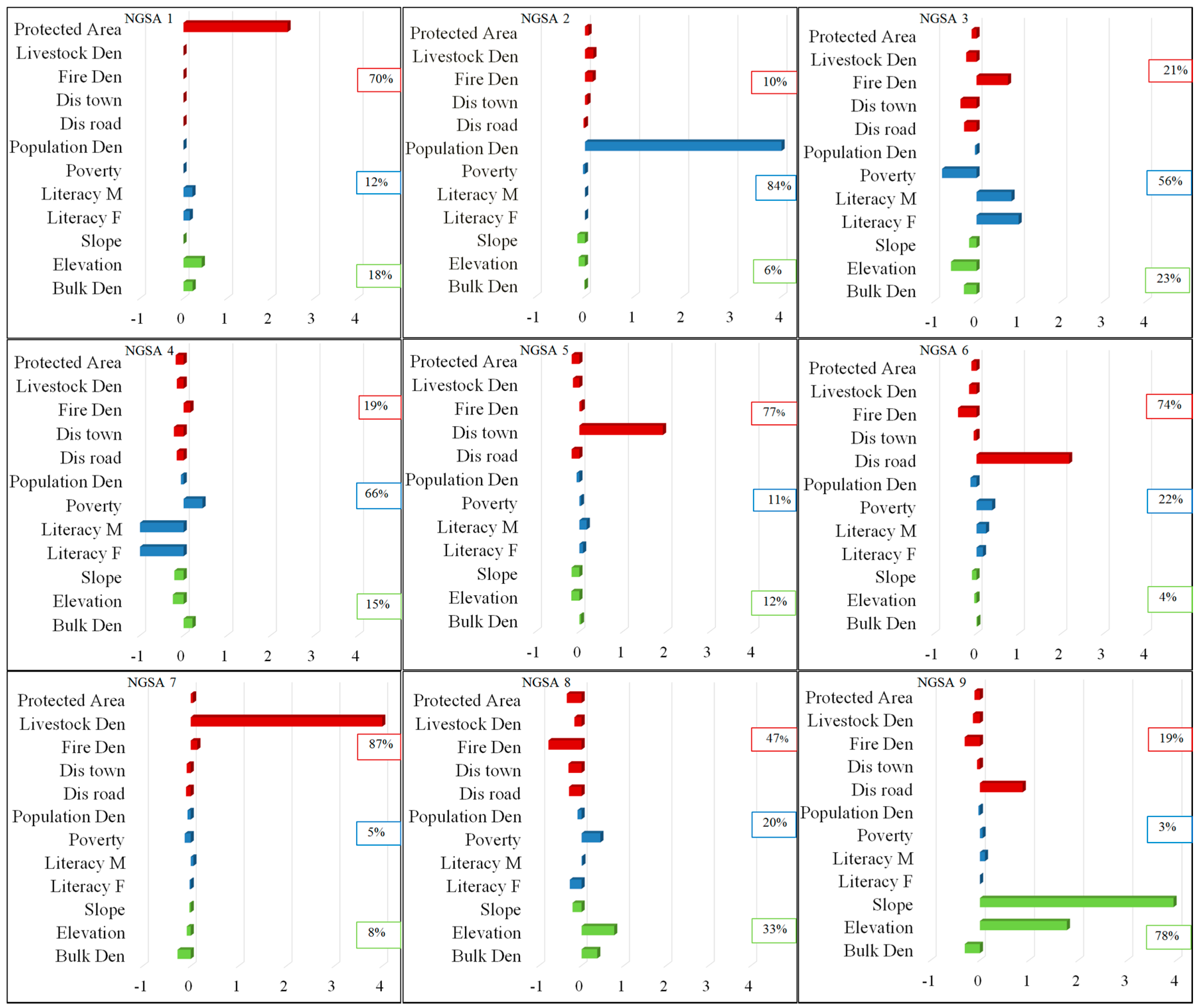
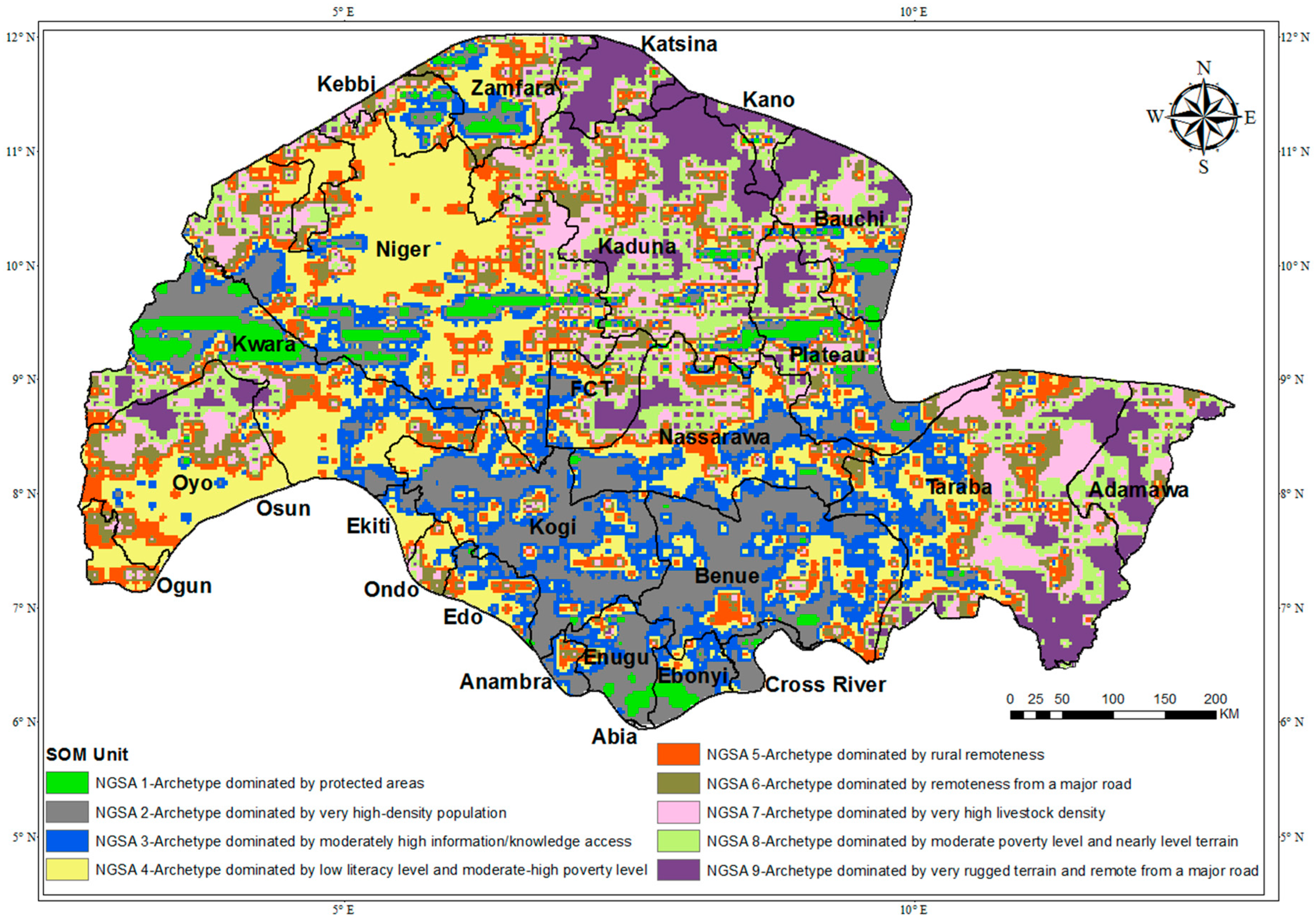
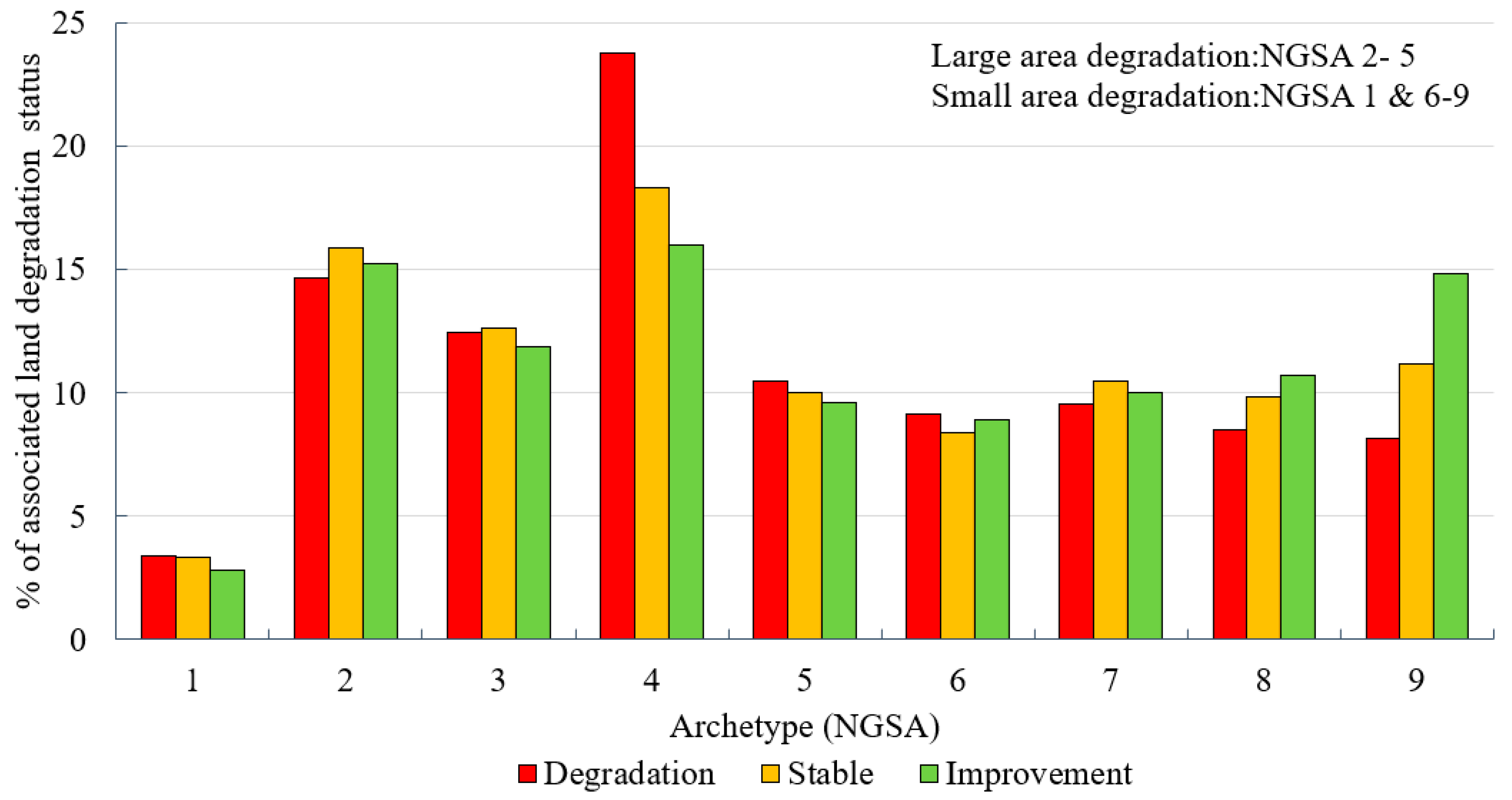
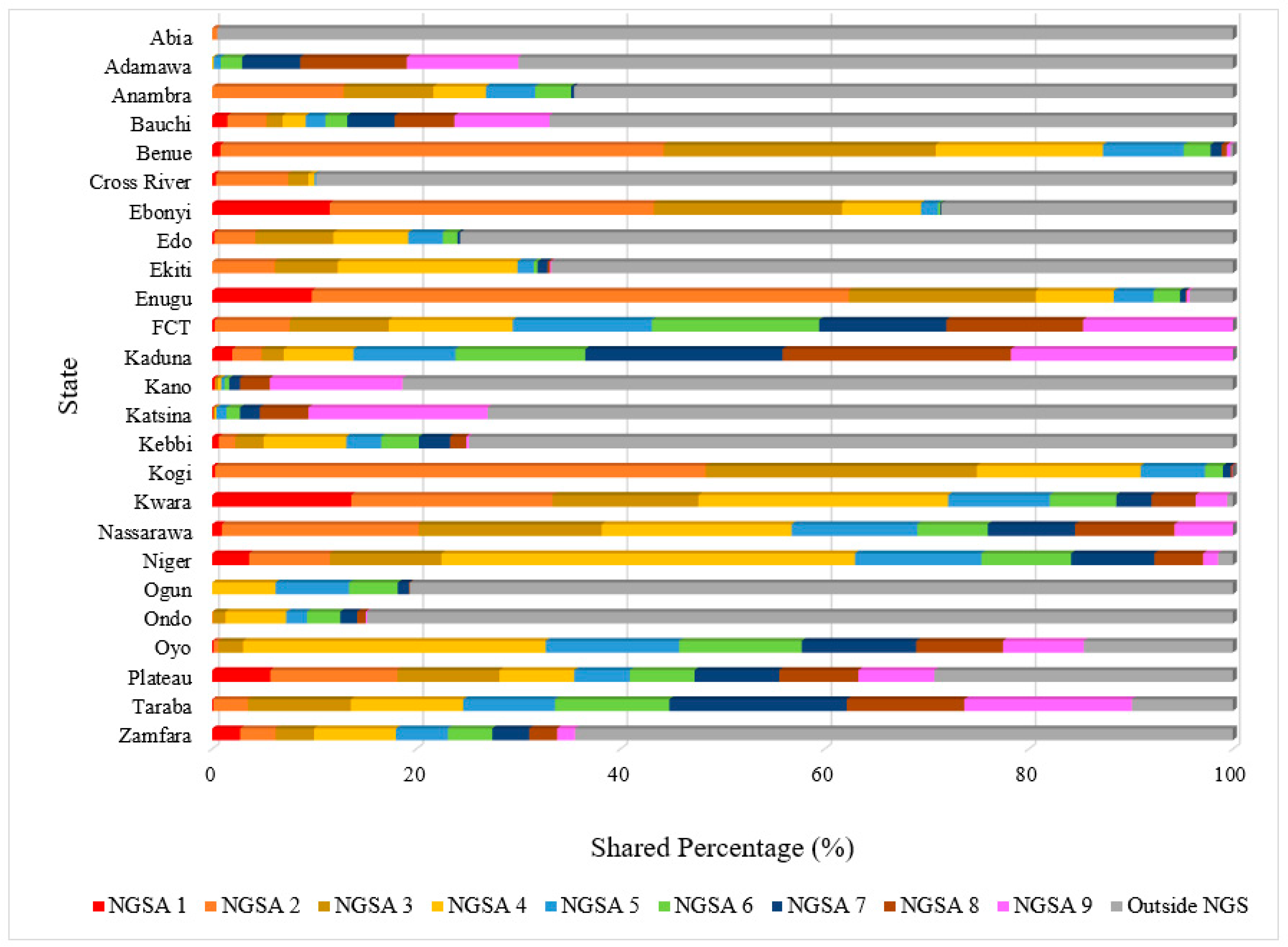
| (1a) Land-Use Management Practices | ||||
| Variables | Type of Driver | Explanation | Hypothesized Effect | References |
| Fire occurrence density derived from active fire and hotspot data | Proximate | Uncontrolled fire occurrences and bush burning destroy soil and biomass, leading to LD—while controlled fire could be a management strategy. | Frequent man-made fire activities lead to more LD. The fewer the man-made fire activities, the less the LD. | [44,45,46] |
| Livestock grazing intensity | Proximate | Overgrazing due to higher livestock intensity leads to LD, especially when the threshold limits of the support systems are exceeded, while lower livestock intensity does not lead to LD. | The higher the livestock grazing density, the higher the LD. The lower the grazing density, the less the LD. | [47,48] |
| Distance to major road | Proximate/Anthropogenic | Roads are a measure of infrastructural development that enhances access to markets and extension services. For instance, a good access road encourages land conversion, including the spread and the adoption of land management practices, while inadequate access discourages land conversion. | Proximity drives LD because nearer forest patches are easier to clear, while areas far away are not affected. The farther an area to a major road, the less the LD; the closer to a major road, the more the LD. | [16,29,38,49] |
| Distance to major towns | Proximate/Anthropogenic | Land that is close to major towns is prone to LD pushed by urban development; while land that is far from major towns is less prone to conversion and LD. | The farther an area to a major town, the less the LD; the closer to a major town, the more the LD. Areas near settlements or towns are more likely to degrade due to expanding settlements and resource extraction (e.g., wood). | [16,17,29] |
| Protected area status | Proximate | Human pressure that causes LD is more severe on unprotected land than on protected land. | Protected areas are less prone to degradation due to their protected status. | [50,51] |
| (1b) Socio-Economic Drivers | ||||
| Variables | Type of Driver | Explanation | Hypothesized Effect | References |
| Population density | Underlying | Population density can trigger better land management, but can also lead to LD due to overuse or poor management. | The higher the population density, the less the LD; the lower the population density, the more the degradation. Alternatively, the higher the population density, the higher the LD. The lesser the population density, the lesser the LD. | [16,17,35] |
| Female/Male Literacy | Underlying | High literacy indicates better access to information or knowledge for making informed decisions, while low literacy may limit people’s ability to understand available information—hence they are likely to make poorer land management and investment decisions. | The higher the literacy of women/men, the better the access to knowledge on combating LD; the lower the literacy of women/men, the lesser the access to such information. | [38] |
| Poverty head count | Underlying | Diverging evidence. Poverty and LD are intertwined: while poverty could trigger LD, LD could exacerbate poverty. Poor land users are more likely to give up their land tenure security to other more powerful land users, for example losing their land to large-scale land investments for monocultures. | The higher the poverty, the more the prevalence of LD due to various intervening factors such as lack of capital and labor to invest in land management and insecure land tenure. | [16,29,38] |
| (1c) Environmental Drivers | ||||
| Variables | Type of Driver | Explanation | Hypothesized Effect | References |
| Slope | Proximate | Slope influences land-use decisions. Steep lands are often avoided for land-use activities such as cultivation. However, cultivation on non-terraced steep slopes and overgrazing can cause LD such as water and wind erosion. | The steeper the slope, the more susceptible to LD, but the less will be the land’s attractiveness for use. The less steep the slope, the less susceptible to LD but the more the attractiveness for land-use activities. | [16,39,52] |
| Bulk Density (BD) | Underlying | Soils with low bulk density have favorable conditions in terms of soil pore space, texture and organic matter content that influence the choice of land for crop cultivation and biomass clearance. | Low soil bulk density encourages tillage and crop cultivation, while high soil bulk density discourages crop cultivation. The higher the bulk density, the higher the LD; The lower the bulk density, the less the LD. | [41,42,43] |
| Elevation/Topography | Proximate/Anthropogenic | Land uses such as farming, which promote degradation are often practiced on flat terrain while rough or high hilly terrains are avoided. Hence, flat terrains are more likely to be exposed to land-use pressure from crop farming. | The higher the elevation, the more susceptible is the land to LD such as erosion, but the less the land’s attractiveness for use. The lower the elevation, the less susceptible is the land to LD, but the more attractive for land use because of soil attributes such as deeper soils. | [16,53] |
| SOM | Brief Description | Area Share (%) | Area Share (km2) |
|---|---|---|---|
| NGSA 1 | Archetype dominated by protected areas: Areas with very high numbers of protected areas that are associated with the moderate–high influence of elevation, bulk density and high literacy. | 3.3 | 14,412 |
| NGSA 2 | Archetype dominated by very high-density population: Areas with very high population density and with minimal influence of livestock and high fire activities. | 15.3 | 67,169 |
| NGSA 3 | Archetype dominated by moderately high information/knowledge access: Mainly areas with a moderately high level of both male and female literacy, including fire-occurrence activities but with low poverty. | 12.4 | 54,528 |
| NGSA 4 | Archetype dominated by low literacy level and moderate–high poverty level: Area characterized by moderate–high poverty and minimal fire activities, but with low levels of both male and female literacy. | 20.1 | 88,036 |
| NGSA 5 | Archetype dominated by rural remoteness: Highly dominated by land-use management practices and remote from major towns but with a moderately low population density, protected area prevalence, and low livestock density. | 10.1 | 44,408 |
| NGSA 6 | Archetype dominated by remoteness from a major road: Highly dominated by land-use management practices, which occur at a far distance away from major roads with moderately high poverty and literacy but with moderate fire and livestock activities. | 8.7 | 38,273 |
| NGSA 7 | Archetype dominated by very high livestock density: Areas with a very high livestock density and moderate levels of other drivers. | 10.1 | 44,044 |
| NGSA 8 | Archetype dominated by moderate poverty level and nearly level terrain: Collectively driven by all drivers’ categories but fairly dominated by land-use management practices, but with a moderate elevation and moderate influence of bulk density and poverty. | 9.4 | 41,297 |
| NGSA 9 | Archetype dominated by very rugged terrain and remote from a major road: Areas with moderate elevation, high slope, and distant from the major road. | 10.5 | 45,880 |
| 100.00 | 438,046.88 |
Publisher’s Note: MDPI stays neutral with regard to jurisdictional claims in published maps and institutional affiliations. |
© 2020 by the authors. Licensee MDPI, Basel, Switzerland. This article is an open access article distributed under the terms and conditions of the Creative Commons Attribution (CC BY) license (http://creativecommons.org/licenses/by/4.0/).
Share and Cite
Adenle, A.A.; Ifejika Speranza, C. Social-Ecological Archetypes of Land Degradation in the Nigerian Guinea Savannah: Insights for Sustainable Land Management. Remote Sens. 2021, 13, 32. https://doi.org/10.3390/rs13010032
Adenle AA, Ifejika Speranza C. Social-Ecological Archetypes of Land Degradation in the Nigerian Guinea Savannah: Insights for Sustainable Land Management. Remote Sensing. 2021; 13(1):32. https://doi.org/10.3390/rs13010032
Chicago/Turabian StyleAdenle, Ademola A., and Chinwe Ifejika Speranza. 2021. "Social-Ecological Archetypes of Land Degradation in the Nigerian Guinea Savannah: Insights for Sustainable Land Management" Remote Sensing 13, no. 1: 32. https://doi.org/10.3390/rs13010032
APA StyleAdenle, A. A., & Ifejika Speranza, C. (2021). Social-Ecological Archetypes of Land Degradation in the Nigerian Guinea Savannah: Insights for Sustainable Land Management. Remote Sensing, 13(1), 32. https://doi.org/10.3390/rs13010032






